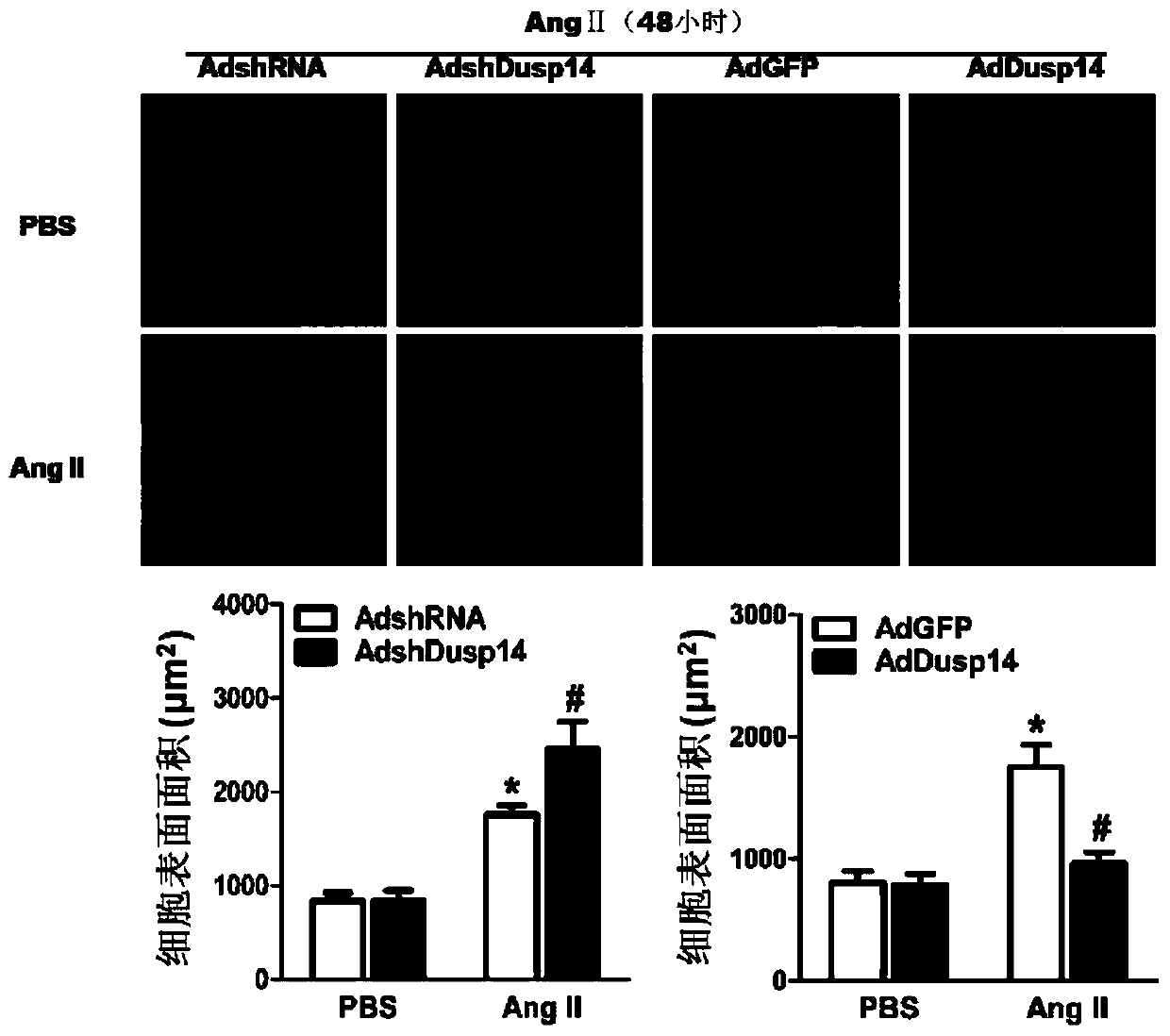Function and application of dual specificity phosphatase 14 (dusp14) in the treatment of cardiac hypertrophy
A bispecific, myocardial hypertrophy technology, applied in the field of gene function and application, can solve problems such as malignant arrhythmia, myocardial cell apoptosis, myocardial ischemia, etc., to achieve inhibition of cardiac hypertrophy, anti-cardiac fibrosis effect on heart function
- Summary
- Abstract
- Description
- Claims
- Application Information
AI Technical Summary
Problems solved by technology
Method used
Image
Examples
Embodiment 1
[0079] Example 1 Expression of DUSP14 in the hearts of normal people and patients with cardiomyopathy
[0080] SDS-PAGE-Western blot test (Western blot) was performed on proteins extracted from the hearts of normal human hearts (individuals donated by non-cardiac causes of death) and hearts of patients with dilated cardiomyopathy (recipients replaced by patients undergoing heart transplantation, DCM). ), combined with antibodies that specifically recognize DUSP14 protein and cardiomyocyte hypertrophy markers ANP (Millipore, AB2232) and Myh7 (santa cruz, sc53090) to detect the expression of DUSP14 (Abnova, PAB4143), and GAPDH (Cell Signaling Technology, 2128) as an internal reference. Test results such as figure 1 As shown, the expression of cardiomyocyte hypertrophy markers ANP and Myh7 in the hearts of patients with dilated cardiomyopathy was significantly up-regulated, and the expression of DUSP14 was significantly down-regulated ( figure 1 ).
Embodiment 2
[0081] Example 2 Expression of DUSP14 in the heart of wild-type mouse sham operation group and cardiac hypertrophy model group
[0082] 1. Aortic arch constriction (AB) was used to establish a mouse model of myocardial hypertrophy. The model operation process:
[0083] 1.1 Preoperative preparation
[0084] (1) Anesthesia: First weigh the mice, calculate the required amount of anesthetic (3% pentobarbital sodium) according to 90 mg / kg body weight, inject intraperitoneally, and record the injection time point. There is no obvious reaction between tail and toe pinching and the mouse is in good condition. This is the standard for successful anesthesia (generally there is no obvious reaction about 10 minutes after injection, and the mouse has a reaction to pinch toe about 50 minutes after anesthesia, and about 30 minutes after anesthesia is the best operation time).
[0085] (2) Preparation of the operation area: the skin of the left chest, left chest and armpit of the left foreli...
Embodiment 3
[0096] Example 3 Effect of DUSP14 interference (Adsh DUSP14) and overexpression (Ad DUSP14) adenovirus on the hypertrophy of Ang II-stimulated primary cardiomyocytes
[0097] 1. Primary neonatal SD rat cardiomyocyte culture
[0098] (1) Eight newborn Sprague-Dawley suckling mice were sterilized with 75% alcohol below the neck, and the heart was removed with ophthalmic scissors and micro forceps, and placed in a glass plate filled with 10mL DMEM / F12 solution. Take another one and repeat the above process.
[0099] (2) Wash the heart with DMEM / F12 medium, and cut the heart into 1-2mm 3 fragments. Transfer to a serum bottle with a rotor, suck off DMEM / F12, and add trypsin digestion solution. Rotate at 120r / min, digest for 15min, rest for a few seconds, and discard the supernatant.
[0100] (3) Add trypsin digestion solution, the speed is 120r / min, and digest for 15min. Stand still for a few seconds, aspirate the supernatant, terminate the digestion with DMEM / F12 medium with ...
PUM
 Login to View More
Login to View More Abstract
Description
Claims
Application Information
 Login to View More
Login to View More - R&D
- Intellectual Property
- Life Sciences
- Materials
- Tech Scout
- Unparalleled Data Quality
- Higher Quality Content
- 60% Fewer Hallucinations
Browse by: Latest US Patents, China's latest patents, Technical Efficacy Thesaurus, Application Domain, Technology Topic, Popular Technical Reports.
© 2025 PatSnap. All rights reserved.Legal|Privacy policy|Modern Slavery Act Transparency Statement|Sitemap|About US| Contact US: help@patsnap.com



